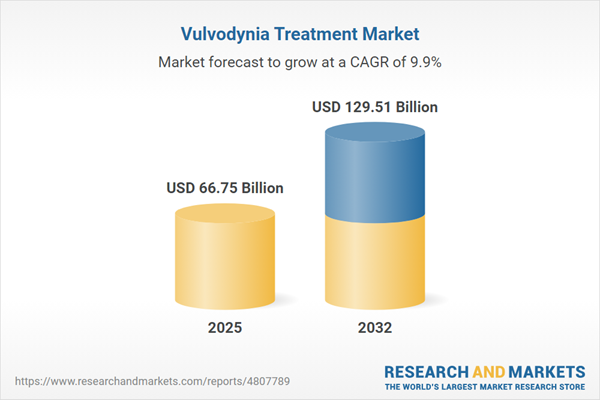Speak directly to the analyst to clarify any post sales queries you may have.
The vulvodynia treatment market is experiencing significant transformation driven by patient-centered care strategies and ongoing shifts in healthcare delivery. Senior executives face decisions shaped by emerging therapies, evolving regulatory landscapes, and the integration of advanced health technologies.
Market Snapshot: Vulvodynia Treatment Market Size and Momentum
The global vulvodynia treatment market reached USD 60.82 billion in 2024, with growth projected to USD 66.75 billion in 2025 and a long-term forecast of USD 129.51 billion by 2032, reflecting a compound annual growth rate of 9.90%. Market advancement is supported by expanded clinical recognition and extensive research investment, resulting in greater adoption of advanced therapies. As regulatory frameworks evolve, both traditional pharmaceutical firms and innovative entrants are driving new product development and care models. Real-time analytics and agile approaches are increasingly critical for organizations seeking to capitalize on market momentum and respond swiftly to industry change.
Scope & Segmentation: Strategic Drivers in the Vulvodynia Treatment Market
- Treatment Type: Non-pharmacological therapies, such as pelvic floor physical therapy and neuromodulation, are integrated alongside pharmacological options including topical anesthetics, anticonvulsants, and antidepressants. Advances in precision medicine and personalized care strategies are expanding treatment effectiveness for individual patient needs.
- Administration Route: Treatment delivery ranges from injectable therapies to oral medications and topical formulations, supporting options for both clinical and home-based care. Patient demand for minimally invasive interventions, such as OnabotulinumtoxinA therapy, remains strong.
- End User: Hospitals, specialty clinics, and at-home care environments encapsulate a multidisciplinary management approach and broaden access across the care continuum.
- Regional Coverage: Key regions span the Americas, EMEA, and Asia-Pacific, each with distinct payer mechanisms, regulatory requirements, and societal attitudes. Regional understanding is critical for successful market entry and adapting business models to local needs.
- Key Companies Profiled: Leading companies—Pfizer Inc., Viatris Inc., Teva Pharmaceutical Industries Ltd., Eli Lilly and Company, Novartis AG, Endo International plc, Astellas Pharma Inc., Perrigo Company plc, Hikma Pharmaceuticals PLC, and Sun Pharmaceutical Industries Ltd.—continue to set competitive benchmarks and influence therapeutic standards globally.
Key Takeaways: Strategic Insights for Senior Decision-Makers
- Multidisciplinary approaches are essential to managing complex pelvic pain syndromes, enabling comprehensive solutions across acute and ongoing treatment phases.
- Adoption of digital health technologies—including telemedicine consultations and remote patient monitoring—supports tailored treatment planning and modernizes the patient-provider interaction.
- Strategic partnerships across pharmaceutical, biotechnology, and specialty care sectors foster innovation and accelerate the pace at which new therapies reach the market.
- Responsive adjustment of clinical protocols in line with payer and policy updates enhances compliance, secures reimbursement, and builds organizational resilience.
- Growth of outpatient and home-based care models expands patient reach, offers operational scalability, and optimizes resource allocation within healthcare organizations.
- Continuous collaboration with regulatory and reimbursement authorities facilitates timely adaptation to changing requirements and safeguards product access.
Tariff Impact: Navigating U.S. Import Duties
Ongoing modifications to U.S. pharmaceutical tariffs are prompting sector-wide reassessment of sourcing and manufacturing strategies among vulvodynia therapy providers. Moving toward domestic production supports greater supply chain resilience and compliance with evolving regulatory expectations. Regularly reviewed tariff impacts enable swift organizational adaptation, strengthen market positioning, and ensure that essential therapies remain accessible in policy-driven care environments.
Methodology & Data Sources
The report integrates insights from in-depth interviews with industry experts, comprehensive reviews of medical literature, and analysis of clinical registry data. This combined methodology enables senior leaders to access reliable, actionable information tailored to the intricacies of the vulvodynia treatment sector.
Why This Report Matters
- Supports informed decision-making for executives facing rapidly changing payer and regulatory frameworks, empowering resource allocation and innovation-focused planning.
- Delivers structured evaluation of care model innovations and emerging technologies, offering actionable insight for organizations adapting to evolving clinical and market conditions.
- Facilitates integration of advanced care approaches, enabling measurable operational and patient outcome improvements for stakeholders in vulvodynia treatment solutions.
Conclusion: Driving Forward in Vulvodynia Care
With focused innovation and true collaboration, organizations can meet shifting market demands and advance the quality of care. Patient-centric leadership ensures lasting growth and better outcomes within the vulvodynia treatment landscape.
Additional Product Information:
- Purchase of this report includes 1 year online access with quarterly updates.
- This report can be updated on request. Please contact our Customer Experience team using the Ask a Question widget on our website.
Table of Contents
3. Executive Summary
4. Market Overview
7. Cumulative Impact of Artificial Intelligence 2025
Companies Mentioned
The companies profiled in this Vulvodynia Treatment market report include:- Pfizer Inc.
- Viatris Inc.
- Teva Pharmaceutical Industries Ltd.
- Eli Lilly and Company
- Novartis AG
- Endo International plc
- Astellas Pharma Inc.
- Perrigo Company plc
- Hikma Pharmaceuticals PLC
- Sun Pharmaceutical Industries Ltd.
Table Information
| Report Attribute | Details |
|---|---|
| No. of Pages | 190 |
| Published | October 2025 |
| Forecast Period | 2025 - 2032 |
| Estimated Market Value ( USD | $ 66.75 Billion |
| Forecasted Market Value ( USD | $ 129.51 Billion |
| Compound Annual Growth Rate | 9.9% |
| Regions Covered | Global |
| No. of Companies Mentioned | 11 |









